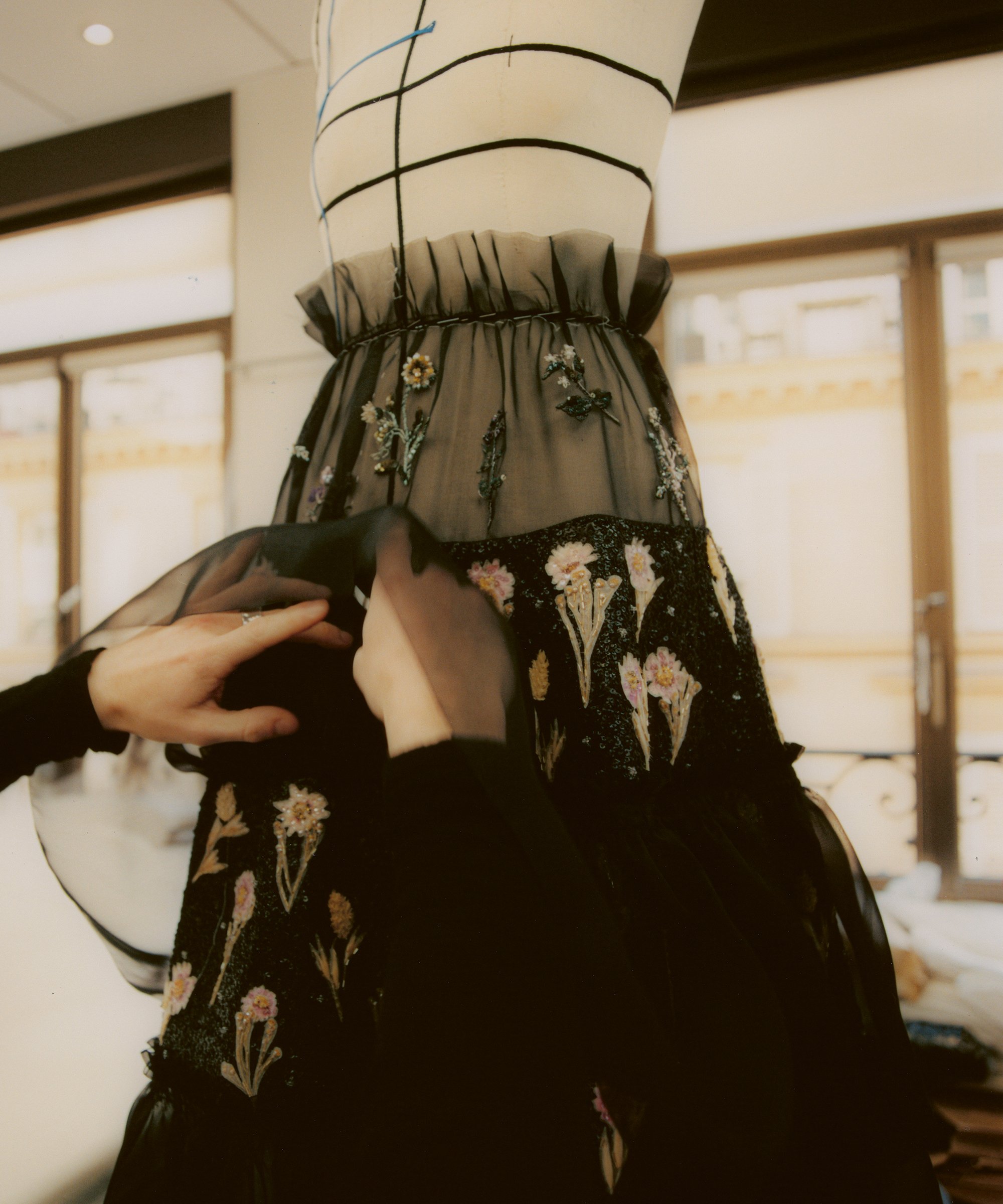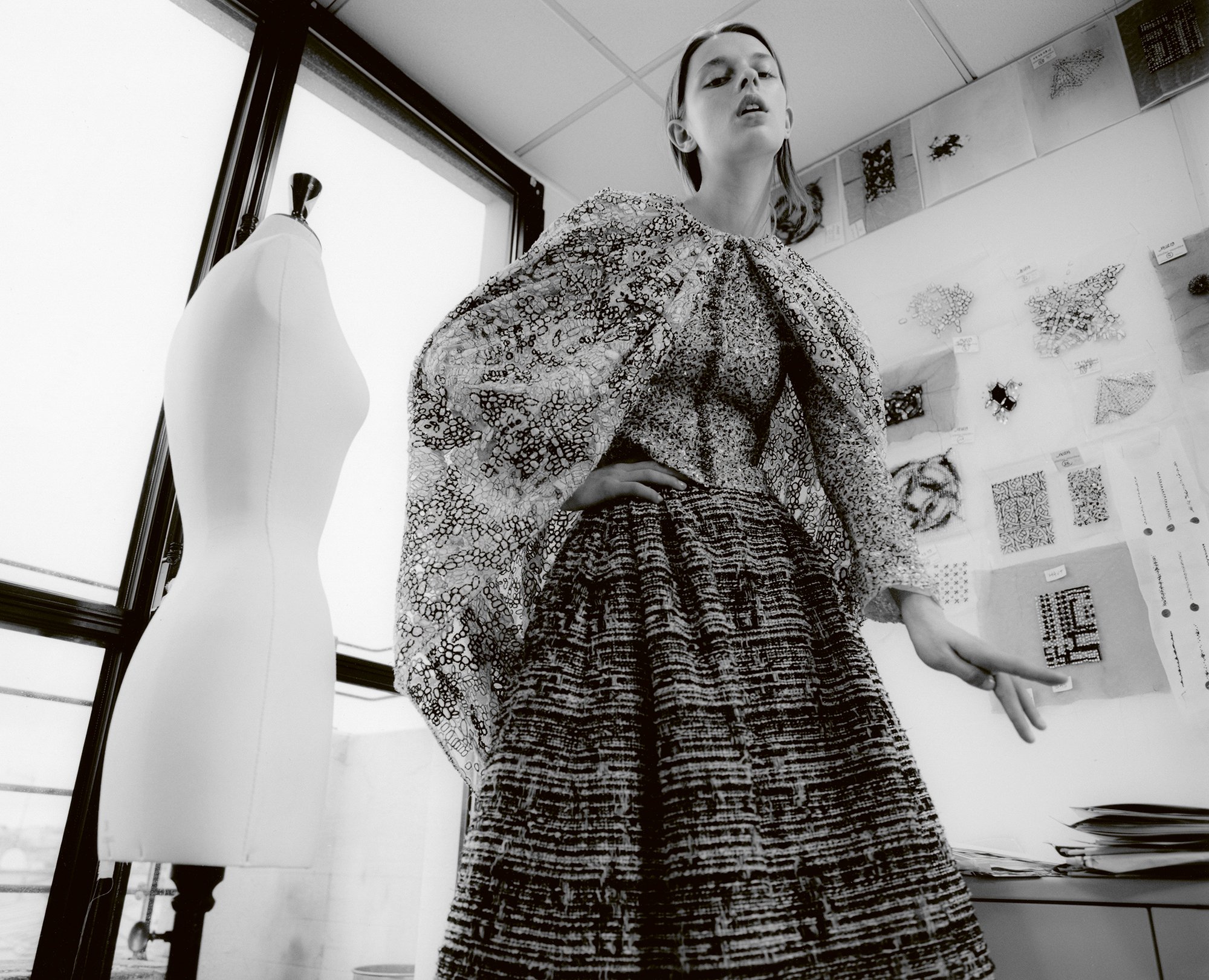Chanel — Through the Looking-Glass
CHANEL: Through the Looking-Glass
Words Anas Koubaiti Photography Stefan Dotter
Styling Christina Ahlberg
When Mademoiselle Chanel presented her Haute Couture collections, the silhouettes would walk down the iconic stairway of her rue Cambon salon, decorated with vertical mirrors. Its fragmented and infinitely multiplied reflection has been one of the dressmaker’s most emblematic images. Yet the essence of Chanel Haute Couture does not only reside in this pure imagery but also the other side of these mirrors. One must go through the looking-glass to uncover the other side of the fascinating world of the Haute Couture ateliers and Métiers d’Art ateliers. Indeed, Haute Couture remains a limitless realm of expression, an exceptional territory that distinguishes itself through an internationally unique kind of craftsmanship.
Since 1985 Chanel has contributed to shedding light on and saving this artistry by cooperating with twelve Maisons d’Art and twenty-two manufacturers that still provide irreplaceable and unique skills for luxury houses and the world of luxury. Through this engagement, Chanel is not only taking part in the preservation but also an active promotion of new generations of talent. Parisian embroiderers, flower makers, pleaters, goldsmiths, glove makers, button and ornamentation manufacturers, plumassiers, shoemakers and milliners all gather under the beautiful name of Paraffection (“By Affection”) and retain their independence while continuing to use their expertise in dedication to Haute Couture and Métiers d’Art collections.
For the Haute Couture Spring-Summer 2020 collection, Virginie Viard, Artistic Director of Chanels’s Fashion collections, and her creative studio have investigated the symbolic potential of a modest well standing in Aubazine’s gardens, an abbey in central France. The location is one of fundamental personal significance for Gabrielle Chanel, who spent part of her childhood there. In this abbey, one can still decipher the origin of a great share of the house’s codes and idiosyncrasies, whether through the interlacing of the two Cs in the monochrome stained-glass windows, the Maltese crosses, the moons in the pebble paving or the austerity of the little schoolgirl dresses which were likely to inhabit the place when it hosted an orphanage.
The result is eminently humble. It is a rare feat in Haute Couture, which is undoubtedly due to the perilous and almost autophagic exercise of extracting the very DNA of the house, of the scenery which saw the birth of Mademoiselle Chanel’s vocation. References to Aubazine can be found anywhere, in the most subtle, abstract, and least evident manner. It is disseminated in each gesture and every choice, and it thus becomes an essence; a roaming spirit.
In the process of creation, Chanel allowed each Métier d’Art to contribute by providing its own interpretation of this Cistercian architecture and its cloister that blossoms in spring. Each piece has been planned and built in a ballet of movement back and forth between the ateliers and the Haute Couture ateliers. Just like Alice, one has to follow each one of them minutely by going through fragile and partial patronage pieces, on a path bringing together several know-hows, a succession of worlds that explore Aubazine and its garden. It is a world where the embroidery must be read upside down, where meaning only takes shape at the very end of the process, whose understanding requires an initiation. While visiting this collection, Chanel takes us to the other side, in the workshops of three prominent figures of the Métiers d’Art, the embroiderers Montex and Lesage, and the flower maker and plumassier Lemarié.
Montex:
Meaning under the Influence
of Abstraction
Under the eaves of Montex ateliers, Artistic Director Aska Yamashita offers us the keys to understanding a certain kind of embroidery with radical graphic design. The fashion house, created in the late 1930s, captures us in a wild abstraction exercise where the very essence of the abbey is embodied by the tulle, with an interpretation influenced by architectural perspectives. In every sample offered, neither the message nor the technicity are obvious. They are both indecipherable, yet they are nonetheless present in every piece.
The plans of the Cistercian abbey have been carefully hand drawn on thin transparent rhodoids before reducing this meticulous work into minuscule sequin-sized portions. The deconstructed architectural plan dresses up an entire bustier with needlework. Thanks to expert hands that have dexterously manipulated the centenary Cornely machines, the pavings of Aubazine have become fluid, light and translucent, covering an entire cape in the making with an organic pebble-like pattern. Real flowers that have been delicately dried between two layers of tulle are captured in the embroidery. The parterres of the cloister thus float over the template of a sleeve or a slip in the shape of an herbarium.
Maison Lesage:
An audacious and fairylike Oneirism
At the Maison Lesage, one can examine some of the most spectacular works of the house for Chanel in the archive room that contains one of the greatest collections of Haute Couture embroidery in the world. From supple and re-embroidered 3D prints to a tribute to Le Corbusier in articulated concrete links, as well as Egyptophile compositions revisiting the Memphis style of Ettore Sottssas, it appears that innovation and experimentation are important principles at Lesage’s.
Although one is dealing with a niche industry, the fashion house argues for an embroidery of its time, embodying values and striving to be sustainable by using recycled plastic flowers and acetate glitter. All in all, “anything is possible in embroidery, one only has to dream it up” says Hubert Barrère. Once this message has been conveyed, the Artistic Director of Maison Lesage can finally take us into the workshops where the “embroidering fairies”, as he likes to call them, are at work. They are busy working meditatively in monastic silence on an imposing six-piece project. On this wedding veil, wisteria flowers are flowing together in a barely perceptible nuance of pink and mauve, which hang onto the evanescent interlacing circles of the Aubazine stained-glass windows. Elsewhere, daisies and other floral patterns bloomed on vaporous-looking tulle. This prowess is subliminal. The pieces are so unreal, so light that one almost wonders whether they’re tangible, similar to the dreams that appear so vividly real to us then draft out of reach upon waking.
Maison Lemarié:
The miraculous Profusion
In the cutting room of Maison Lemarié (under the artistic direction of Christelle Kocher) one of the last flower makers and plumassiers in Paris, over a hundred cutting tools piled up since 1880 enable the conception of an infinite variety of floral compositions. The petals of the iconic camellias, peonies, dahlias, carnations, tulips, poppies, jasmines, orchids and roses can be featured in feather, muslin, organza, tulle, leather or velvet before the edge of each of them gets carefully topstitched by hand. Each of these flowers will then be placed on a carefully chosen spot on its previously drawn and coloured representation.
In this house of centenary experience, which has been a choice partner of Chanel since the 1960s, the templates of bustiers, sleeves and slips, seem to miraculously blossom like gardens in spring. This miracle is enabled by the dedication of small hands, busying themselves on the fabric in a buzzing hive. As if by magic, they give birth to splendid adornments, and constantly defy the creative limits and possibilities of fabrics and feathers.
In “The Garden of Live Flowers”, each flower, each feather, each butterfly, each composition is unique and is added to a garden of all possibilities. This profusion can be applied in all directions, to the generosity of ornaments but also to the materials, shapes and drawings Maison Lemarié is capable of offering.
Haute Couture at Chanel is in some ways a synecdoche, where one part refers to the whole and vice versa. In the four Haute Couture ateliers of the rue Cambon, the contributions of each Métier d’Art take part in a general vision that finally takes shape there.
In the tailoring ateliers, the pavings of Aubazine dress up the deconstructed drawings of the abbey. In the ateliers flou, hundreds of flowers start floating on volumes with subtle shades of transparency. The wedding veil sublimates a little white dress that brings a sobriety only mitigated by the jewel buttons. Each of the pieces carries an effort, a meaning, invested in each choice of lining, in the tint of each superposed layer of tulle, in each needlework, in each chirurgical application of each Guipure lace. It is minute and colossal work — which the layperson is often oblivious to.
The essential contribution of the craftsperson may seem unintelligible and difficult to grasp; one will often focus only on the aesthetic result, but the beauty of the process, of the creativity, of the wonderland behind it, remains waiting at the other end.
Conscious of its inestimable value, the house of rue Cambon is pursuing an unprecedented project of preservation and development. By uniting them under the same roof, Chanel has the ambition to catalyse a creative synergy between the different Métiers d’Art and their respective worlds. Located in the north of Paris, the 19M — M for the words Mains (Hands), Mode (Fashion), Métier (Craftsmanship) — this cloister of know-how will contribute to reinforcing the collegiality that Chanel displays in the act of collaborating with these exceptional artisans.
Make-up Yvane Rocher Hair Nicolas Phillipon
Casting Dominik Wimmer Assistant Louis Dumetz
Model Merel Zoet @ Viva London
All clothing by
CHANEL HAUTE COUTURE
Spring-Summer 2020
Special thanks to
Aska Yamashita, Hubert Barrère
& Sophie Waintraub











